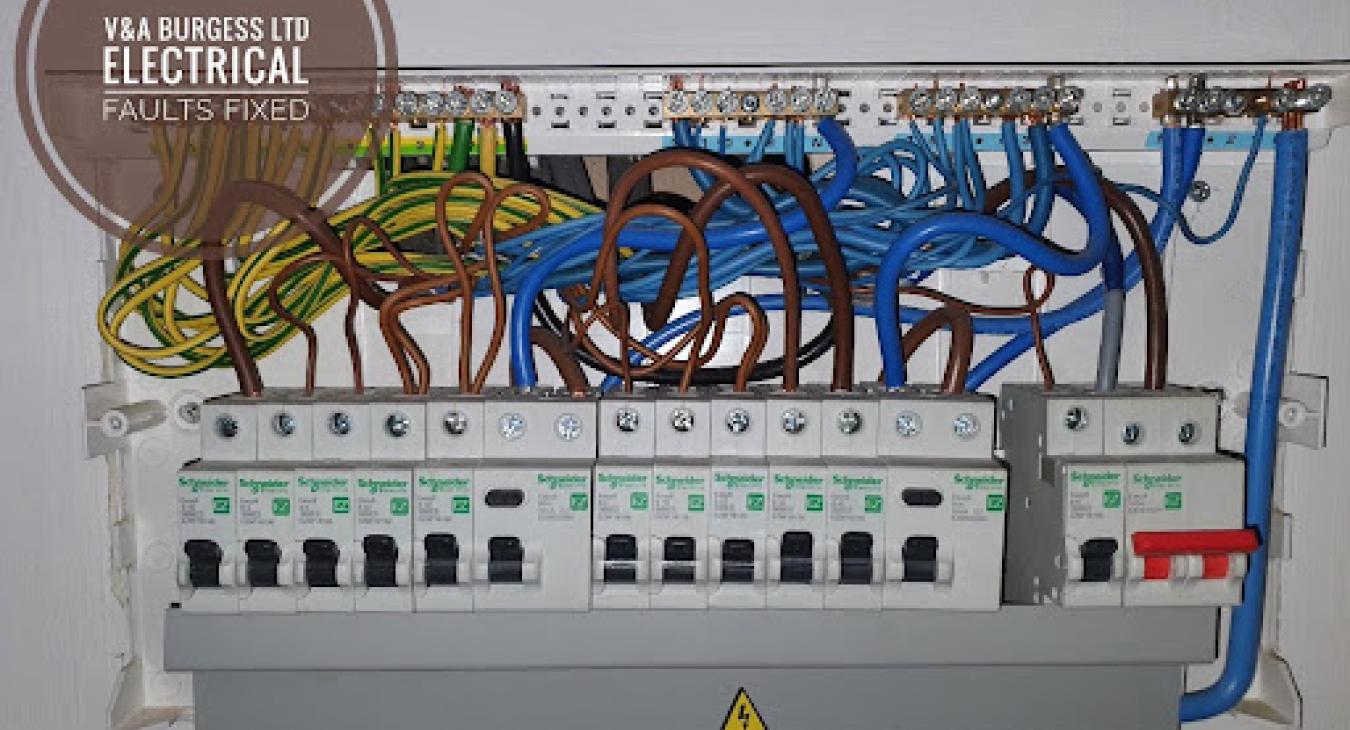
Table of Contents
- In every home, there is a consumer unit (or fuse box in older properties) which is the brains of our home electrical systems. Inside the consumer unit is the CONSUMER UNIT WIRING which splits up the main incoming electrical supply and sends electricity around our homes.
- Components
- Types of Circuits
- Sizing of cables
- Cable colours
- Can I wire a consumer unit myself?
1) In every home, there is a consumer unit (or fuse box in older properties) which is the brains of our home electrical systems. Inside the consumer unit is the CONSUMER UNIT WIRING which splits up the main incoming electrical supply and sends electricity around our homes.
We can see from the photograph that there are multiple wires of different colours and thicknesses inside the consumer unit and each of these has a specific purpose for supplying electrical circuits and equipment around the home.
Back to top2) Components
On the far right of the photograph we have the “Main Switch” which is responsible for turning on and off the entire electrical supply to the consumer unit. The Main Switch is normally rated to 100 amps and should be able to cope with all the demand in the property. This switch is simple a means of isolation for the consumer unit and will not trip in the event of an electrical fault. There are some main switches that are designed to trip but not in this case.
The cable that enters the main switch is much thicker than the other cables inside the consumer unit. This is because the cable entering the consumer unit needs to be able to carry all the electrical current for the property that is then divided into circuits.
Just underneath the Main Switch and beneath all the other switches, hidden by a plastic cover, there is a thick copper bar that carries the electrical current along all the switches. The design of this will vary between different types of consumer unit and sometimes with the brand but its purpose is to split the power from the supply and send it to the other switches (circuit breakers).
Each of the switches will control a different electrical circuit in the home. There will be independent switches for electrical plug socket, lighting and cooker circuits for example and the size of the wires needed to carry the electrical current will vary depending upon the type of electrical circuit.
Back to top3) Types of Circuits
The lighting circuits that supply all the light fittings in your home will be the thinnest cable when it comes to CONSUMER UNIT WIRING as they are normally not required to carry much electrical current as lighting circuits do not generally demand a lot of electrical power. When we compare the wire from a lighting circuit with the wire for an electric shower such as the wire on the far left of the photograph, we can see that the electric shower wire is much thicker than the lighting wire. This is because the electric shower requires much more electrical current to heat water for your shower than a light bulb.
The wires inside a consumer unit, the trip switches and other electrical components have all been carefully selected, designed, and considered by the electrician that completed the installation or replaced the consumer unit. Your electrician will have followed the guidance and regulations laid out in BS7671 Requirements for Electrical Installations when they designed your electrical system to ensure that everything has been carried out according to the safety regulations.
An electric shower that has been wired in a small cable will be extremely dangerous and likely to cause a fire whereas a lighting circuit that has been wired in a very thick cable will be safe but unnecessary and likely to create issues when installing light switches and light fittings.
Back to top4) Sizing of cables
The size of each cable for each circuit is determined by examining a variety of factors as laid out in BS7671. For instance, when selecting the correct cable for an electrical circuit, your electrician will need to take into account the length of the cable required in order to get from the consumer unit to the final point on the circuit, whether the cable is likely to touch or run through thermal insulation, if the cable is likely to run near other electrical cables, any unusual temperatures for instance passing through an airing cupboard and so on. There are a variety of external factors that can influence the size of a cable required when designing an electrical installation and each electrician needs to take these into account before installing new wiring in the home.
Back to top5) Cable colours
You may have noticed that the CONSUMER UNIT WIRING in the photograph is predominantly blue and brown. The blue indicates a neutral cable (usually) and the brown indicates a line cable (also called live). If you have an older home (Pre 2004), your wires may be different colours such as red for line and black for neutral. This is not foolproof though and before attempting ANY DIY work, you should consider if you have the expertise and knowledge in order to do so. Electrical installation and repairs are a specialist job requiring specialist tools and knowledge and as such can be incredibly dangerous if not carried out correctly.
Back to top6) Can I wire a consumer unit myself?
Generally, the straightforward answer is no. There are several requirements that cannot be fulfilled by the DIY enthusiast such as, correct torque setting of devices, specialist knowledge and testing of the installation and notification of the installation to the relevant authority along with the completion of the required installation certification. There are also many ways the project can go wrong whilst in the presence of permanent electric shock risk. It is simply a job that is not worth attempting to cut corners on by doing yourself. Care should also be taken when attempting to obtain the cheapest quote for electrical work as often, vital paperwork may not be issued, guarantees may not be forthcoming and so on.
Should you need any electrical advice then please do not hesitate to get in touch with us and we will do our best to assist you.
Back to top










